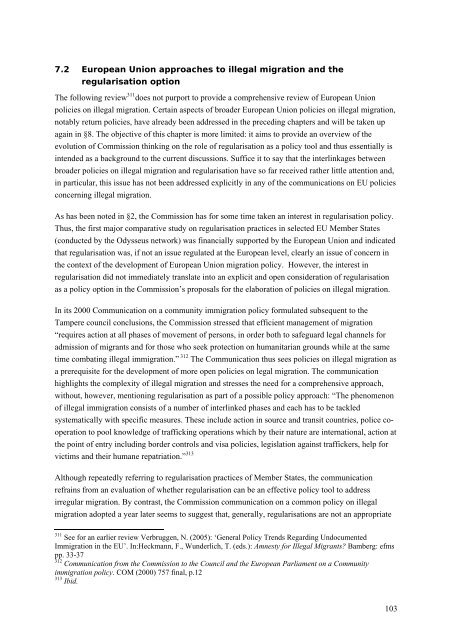REGINE Regularisations in Europe Final Report - European ...
REGINE Regularisations in Europe Final Report - European ...
REGINE Regularisations in Europe Final Report - European ...
You also want an ePaper? Increase the reach of your titles
YUMPU automatically turns print PDFs into web optimized ePapers that Google loves.
7.2 <strong>Europe</strong>an Union approaches to illegal migration and the<br />
regularisation option<br />
The follow<strong>in</strong>g review 311 does not purport to provide a comprehensive review of <strong>Europe</strong>an Union<br />
policies on illegal migration. Certa<strong>in</strong> aspects of broader <strong>Europe</strong>an Union policies on illegal migration,<br />
notably return policies, have already been addressed <strong>in</strong> the preced<strong>in</strong>g chapters and will be taken up<br />
aga<strong>in</strong> <strong>in</strong> §8. The objective of this chapter is more limited: it aims to provide an overview of the<br />
evolution of Commission th<strong>in</strong>k<strong>in</strong>g on the role of regularisation as a policy tool and thus essentially is<br />
<strong>in</strong>tended as a background to the current discussions. Suffice it to say that the <strong>in</strong>terl<strong>in</strong>kages between<br />
broader policies on illegal migration and regularisation have so far received rather little attention and,<br />
<strong>in</strong> particular, this issue has not been addressed explicitly <strong>in</strong> any of the communications on EU policies<br />
concern<strong>in</strong>g illegal migration.<br />
As has been noted <strong>in</strong> §2, the Commission has for some time taken an <strong>in</strong>terest <strong>in</strong> regularisation policy.<br />
Thus, the first major comparative study on regularisation practices <strong>in</strong> selected EU Member States<br />
(conducted by the Odysseus network) was f<strong>in</strong>ancially supported by the <strong>Europe</strong>an Union and <strong>in</strong>dicated<br />
that regularisation was, if not an issue regulated at the <strong>Europe</strong>an level, clearly an issue of concern <strong>in</strong><br />
the context of the development of <strong>Europe</strong>an Union migration policy. However, the <strong>in</strong>terest <strong>in</strong><br />
regularisation did not immediately translate <strong>in</strong>to an explicit and open consideration of regularisation<br />
as a policy option <strong>in</strong> the Commission’s proposals for the elaboration of policies on illegal migration.<br />
In its 2000 Communication on a community immigration policy formulated subsequent to the<br />
Tampere council conclusions, the Commission stressed that efficient management of migration<br />
“requires action at all phases of movement of persons, <strong>in</strong> order both to safeguard legal channels for<br />
admission of migrants and for those who seek protection on humanitarian grounds while at the same<br />
time combat<strong>in</strong>g illegal immigration.” 312 The Communication thus sees policies on illegal migration as<br />
a prerequisite for the development of more open policies on legal migration. The communication<br />
highlights the complexity of illegal migration and stresses the need for a comprehensive approach,<br />
without, however, mention<strong>in</strong>g regularisation as part of a possible policy approach: “The phenomenon<br />
of illegal immigration consists of a number of <strong>in</strong>terl<strong>in</strong>ked phases and each has to be tackled<br />
systematically with specific measures. These <strong>in</strong>clude action <strong>in</strong> source and transit countries, police cooperation<br />
to pool knowledge of traffick<strong>in</strong>g operations which by their nature are <strong>in</strong>ternational, action at<br />
the po<strong>in</strong>t of entry <strong>in</strong>clud<strong>in</strong>g border controls and visa policies, legislation aga<strong>in</strong>st traffickers, help for<br />
victims and their humane repatriation.” 313<br />
Although repeatedly referr<strong>in</strong>g to regularisation practices of Member States, the communication<br />
refra<strong>in</strong>s from an evaluation of whether regularisation can be an effective policy tool to address<br />
irregular migration. By contrast, the Commission communication on a common policy on illegal<br />
migration adopted a year later seems to suggest that, generally, regularisations are not an appropriate<br />
311 See for an earlier review Verbruggen, N. (2005): ‘General Policy Trends Regard<strong>in</strong>g Undocumented<br />
Immigration <strong>in</strong> the EU’. In:Heckmann, F., Wunderlich, T. (eds.): Amnesty for Illegal Migrants? Bamberg: efms<br />
pp. 33-37<br />
312 Communication from the Commission to the Council and the <strong>Europe</strong>an Parliament on a Community<br />
immigration policy. COM (2000) 757 f<strong>in</strong>al, p.12<br />
313 Ibid.<br />
103
















